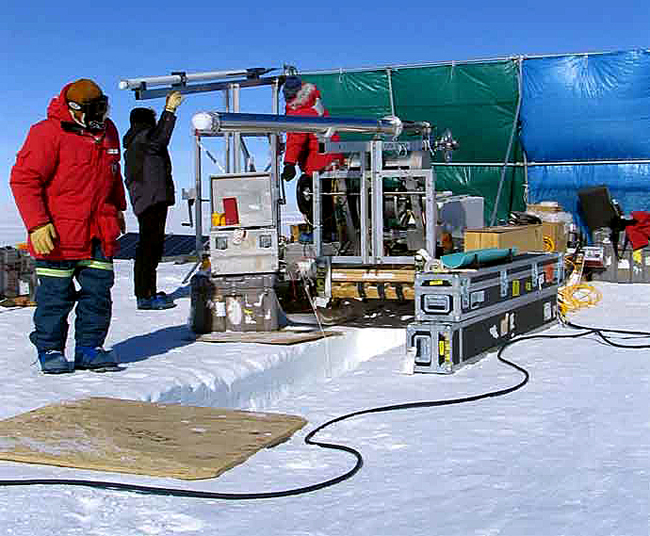
Photo Credit: U.S. ITASE Web site |
The ITASE team sets up a drill camp prior to extracting an ice core. They extract a core about 100 meters long at each site along their route. The various properties of the core, such as density and chemical composition, can tell them something about past climate. |
Interior regions receive little precipitation to offset ice losses at the edges of Antarctica
Mayewski explained the results for the interior regions aren’t too surprising considering the extreme inland temperatures, which can plunge below minus 70 degrees Celsius (minus 100 degrees Fahrenheit) in the winter. A couple degrees of difference, he said, aren’t going to alter significantly the deep-freeze climate in these regions.
“Snow accumulation in the interior isn’t changing yet, even though there’s a bit of warming,” he added. “[That’s] important because that means that sea level contribution of melting Antarctic ice is not necessarily being offset by snow accumulation due to slightly warmer air masses coming into Antarctica.”
It’s what the polar scientists refer to as ice mass balance. The question they want to understand: Is the amount of ice discharged into the ocean by glaciers and the calving of ice shelves being offset by precipitation over the continent? The answer coming from ITASE and other researchers is “no, so far.”
Welch said that, in fact, accumulation rates are regionally variable. Some areas are actually moving into negative territory due to wind scour. “We see a lot of erosion surfaces in East Antarctica,” he explained.
And that thick ice sheet may not be as invulnerable as many believe, Welch said, should the changes chipping away at the continent’s edges propagate inland.
Paul Mayewski on being in the field:
“It’s important to be there. Traverses allow you to be there on site, while you’re doing the science, day to day, while you’re experiencing storms. They’re also very valuable because they’re less dependent on other modes of transportation.”
“We’re finding that water is much more prevalent beneath the ice sheet, particularly in East Antarctica, than we ever thought it was before,” he explained. “Water allows the ice to slide and the glaciers to move much faster, and subsequently respond much quicker [to warming].
“What we’re finding is that there seems to be water everywhere we look,” he added.
That information comes from the deep radar, which Welch explained, is sort of the radio equivalent of a fish finder. In the case of the radar, it picks up differences in the electrical conductivity of the ice rather than density. So it can pick out thin layers in the ice like sulfuric acid, likely from a volcanic eruption, or the presence of water.
“We have a very sensitive system that can detect very small changes,” he said. “It gives us more information with what’s happening to the ice sheet as a whole.”
The deep radar found several subglacial lakes along the route this year, two of which may be previously undiscovered, according to Welch. The role the lakes play in the hydrology of the continent is not well understood, but it appears many of them periodically drain and then refill with surrounding melt water. “What we believe is going on with most of these lakes is that they fill, drain, fill, drain on a somewhat regular basis,” he said.
Said Mayewski of the ITASE program, “Slowly but surely, little bits and pieces of the puzzle are starting to come together.”
To unravel that puzzle further, Mayewski said the ITASE program would shift its focus to the edges of the continent, where dramatic changes in ice flow and temperature are taking place. That means parking the heavy tractors for a while, because those areas slope sharply and boast innumerable crevasses.
“A lot of emphasis for the next few years will be the more coastal sites,” he said.
NSF-funded research in this story: Paul Mayewski, Climate Change Institute at the University of Maine; Brian Welch, St. Olaf College.
Back 1 2





